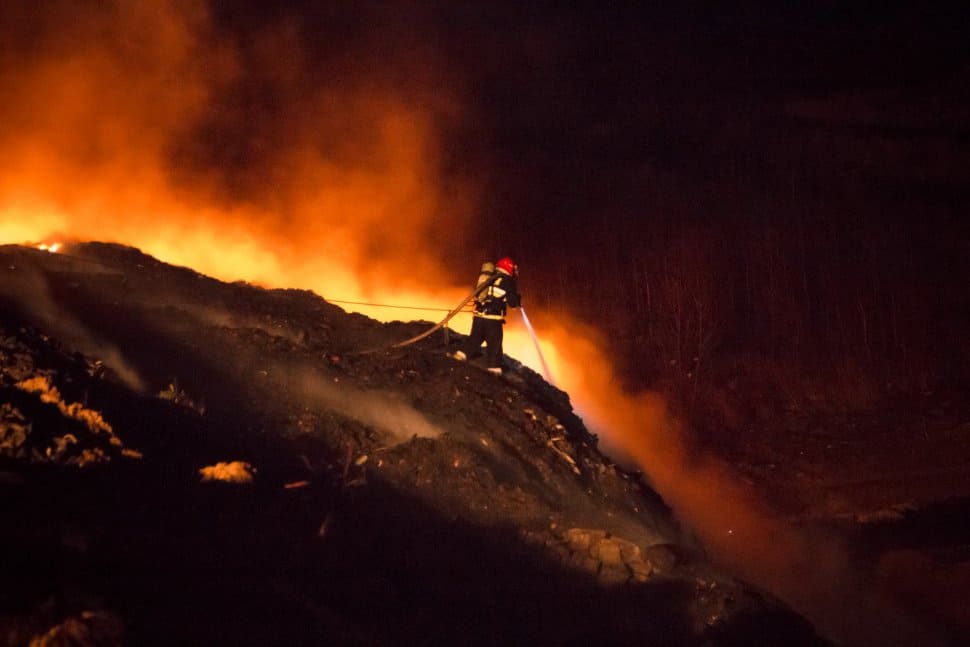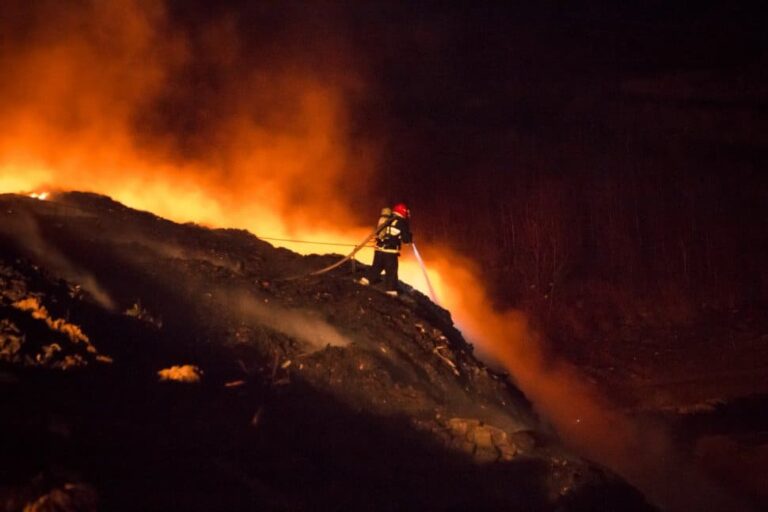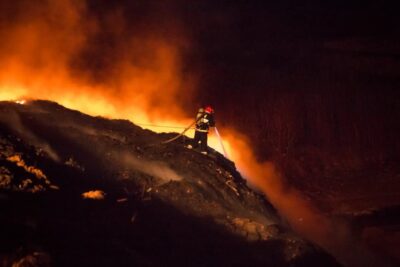Changes in Polish law, introduced after critical wave of burning landfills in 2018, made illegal storage of waste more difficult, but old fraudulent schemes are still in place. Despite increased controls, arrests and high penalties, the cat-and-mouse game between notorious toxic waste handlers and authorities continues. As local governments struggle to find funding for clean-ups, some of the hazardous waste landfills, an equivalent of a ticking time-bomb, are still there.
July 2018 saw an old sawmill on the outskirts of Jakubów, a village in Lower Silesia, repeatedly on fire in what was confirmed an arson. Two hectares of illegal storage burned down, together with the majority of 1,700 pallets storing containers with hazardous chemical waste. In 2016, the landlord applied for a landfill permit but has never received it. Still, for two years, so-called “mauzers” (1000-litre DPPL containers) and 200-litre metal barrels were transported to the site. The regional Inspection of Environmental Protection confirmed it to be filled with hundreds of thousands of litres of paints, solvents, varnishes, sludges, oils remains, and packaging of hazardous substances. While the waste was burning, the owner had already been charged with illegal storage and served with a waste removal order.
The biggest firefighting operation – extremely difficult by exploding barrels – lasted for over a day. Although neighbours later complained of headaches and respiratory problems, local authorities claimed no direct threat to health or the environment.
But independent research by Greenpeace that investigated the site soon after the fire, indicates otherwise: all samples taken at the landfill contained high concentrations of copper and zinc, alongside a long list of highly toxic semi-volatile organic compounds. Organic chemicals were detected in samples from the waste stock, but also from combustion of toxic wastes during the fires. Water flowed from the site of fires to the forest, leaving spruces and pines along its way dead.
Local authorities and residents had been fighting with the landfill owner for two years before the fire, and had to continue for over a year afterwards. “Now the cinders are cleaned up and the landfill is completely closed. It cost our commune approximately 300 thousand zloty [ca. 67,2 thousand euro – VSquare note]. We are entitled to get the money back from the waste owner, but it’s a long way to go” – says the secretary of the commune, Józef Machera. “We have little to no chance of getting our money back. This man is indebted wherever possible, and we are waiting in a long line of creditors.”
The secretary says that the commune could afford the clean-up only because the fire unexpectedly lowered costs: “90% of the containers burnt down, so we had to pay for the utilisation of just 10% of waste, on top of rubble disposal. If it wasn’t for the fire – the waste disposal would cost us around three million zloty. The landscape was terrifying, but now the area is coming back to life.”
The owner of the waste – Janusz G. (for legal reasons his family name cannot be mentioned – VSquare note), a 72-year-old businessman, who was renting the area from a long-bankrupt multi-branch enterprise, was arrested for three months after the fire. Since 2017, he was the subject of an investigation into illegal storage of hazardous waste multiple times. This time the prosecutor’s office accused him of failing to comply with an administrative waste removal order, thus contributing to the fire and bringing a threat to the life and health of many people, as well as to the value of surrounding properties. The man is facing up to 10 years in prison – but the case is still far from over.
“Green list” dirty underneath
The story of arson in Jakubów appears to be a representative illustration of the illegal waste problem in Poland in general. It was one of over 240 – both legal or illegal, hazardous or municipal – landfill fires that took place in Poland in 2018.
As VSquare has learnt, most of the waste was produced in the country. Still, 2018 was also a record year for waste import – Poland imported 434.000 tons of it. And those are only numbers for the legal transactions and only for some types of waste, specifically those from the so-called “amber list”: slags, ashes, batteries, hazardous and other high risk waste which all demand prior notification and consent of sending, transit and destination countries. Data regarding waste from the so-called “green list”, i.e. recyclable materials that are freely moving across European borders, has not been recorded in Poland since 2013.
A permit for a landfilling is easy to obtain, through a decision from a starosta (a district administrator – VSquare note). Also, recyclable materials from the “green list” can be transported on the basis of a simplified permit and it is not necessary to notify any authorities about the waste processing. A contract between the sender and the receiver, and a simple waybill issued by the shipper are sufficient. As a result, waste can easily travel all the way to the place indicated in the document.
Criminals have found many ways to circumvent these laws. The waste handlers use shell companies or strawmen to declare the storage of recyclable materials or the production of alternative fuels. The truckload often turns out to be inconsistent with the declaration. Instead of clean plastics and recyclable materials, trucks contain municipal waste or all kinds of waste from the “amber list” that is forbidden or demands a prior notice to the authority. As long as the waste transport was not claimed by the recipient, it is the sender who is responsible for an incorrectly issued waybill.
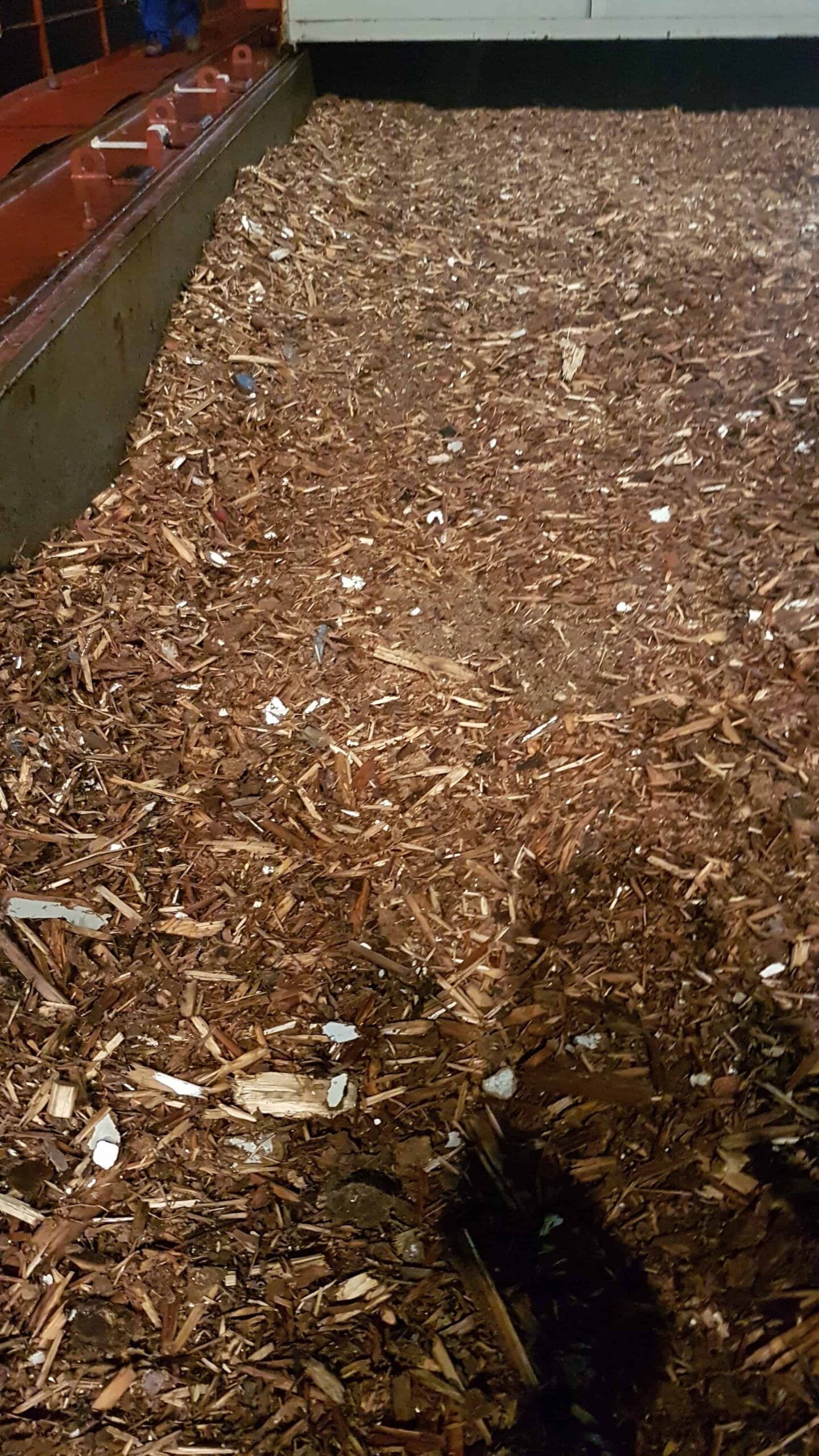
Illegal waste from Norway in Poland. It included mixed “green list” and “amber list” waste, with no import permission. | Photo: gios.gov.pl
On the receiving end, landfills are created on premises leased by front men or owned by bankrupt enterprises. They often happen to be filled beyond capacities, and temporary waste deposits turn out to be permanent. They frequently contain types of waste seriously exceeding the permit framework. In most extreme cases, such as in Jakubów, the semi-legal landfill appears to be a cover for hazardous and toxic waste storage.
Criminals find new ways
In late 2018, the government waged a war on the garbage mafia. Import of all types of waste intended for neutralisation was banned, as well as municipal waste and its derivatives. Officially, only selectively collected waste is allowed to enter Poland, on the condition that it is intended for recycling. Inspection of Environmental Protection is now authorized to carry out intervention checks without prior notice. Landfills that store flammable or hazardous waste are obliged to get CCTV.
But criminals quickly adjust to new laws. It’s no longer just the fraudulent landfills that pose as legitimate businesses. In 2018 the police have issued a warning about a new scheme: fraudulent leasing of warehouses, plots or vacancies, where a massive amount of illegal waste is later dropped without the owners’ knowledge. When the owners or their neighbours ring the alarm bell, it’s already too late – tenants vanish into thin air, leaving toxic waste behind. Frequently, the waste is dropped on recultivated areas as well, buried in the ground or planted in abandoned trailers.
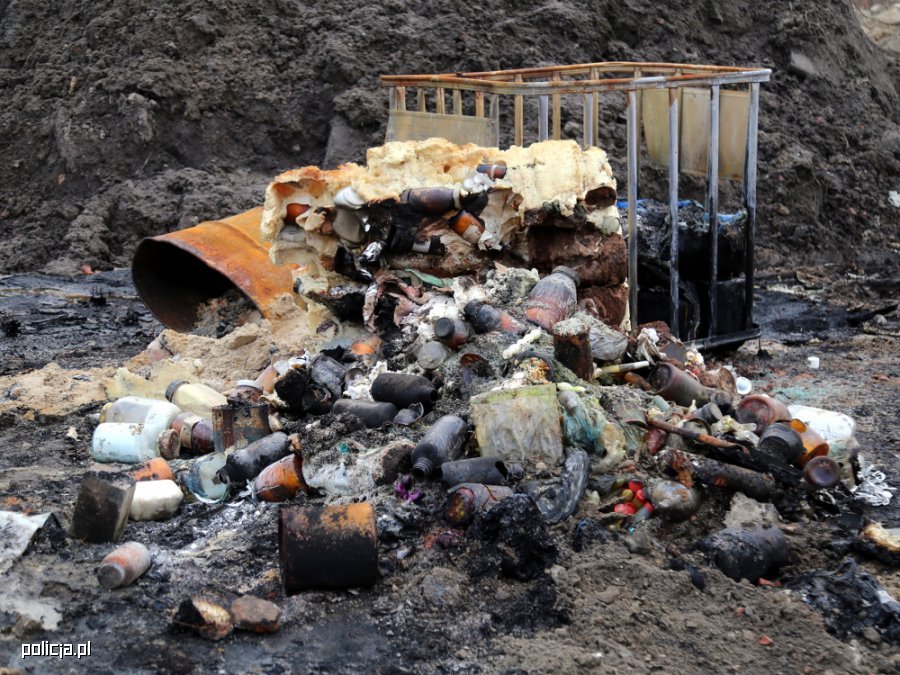
One of the illegal sites uncovered by Polish police | Photo: policja.pl
In 2019 – the first year of the amended Waste Act – 404 968 tons of waste requiring prior notice were imported into Poland, noticeably less than in 2018. 2482 tons – 10 trucks – of illegally transported waste were captured by the Inspection of Environmental Protection through increased control, in comparison to 106 tons in 2018. Most of the stopped transports contained waste that required prior notification of the authorities, mislabelled as recyclables.
In early 2019, the garbage mafia received the first big blow. An analysis of 100 investigations from offices of three prosecutors led to a crackdown on an organized criminal group that accumulated tens of thousands of litres of illegal toxic waste. In Poland alone, the group operated in six voivodeships, storing waste from chemical, petrochemical, dyeing, paint and automotive industries in rented halls. Among 28 detainees so far, there are also Czech and Slovak citizens; waste was transferred across the border and dropped in frontier areas. The utilisation of identified illegal wastelands will cost at least 8 millions zloty. As the investigation is still ongoing, the true scale of the criminals’ operation is yet to be determined.
The legal changes have had also some other effects – the number of fires from 280 in 2018 dropped to over a hundred in 2019. According to the Inspection of Environmental Protection, only 20% of them took place on legitimate landfills. 6% of the fires included toxic waste. The detection rate of illegal practices, such as illegal transboundary movement of waste and illegal hazardous waste dumps, has also increased significantly.
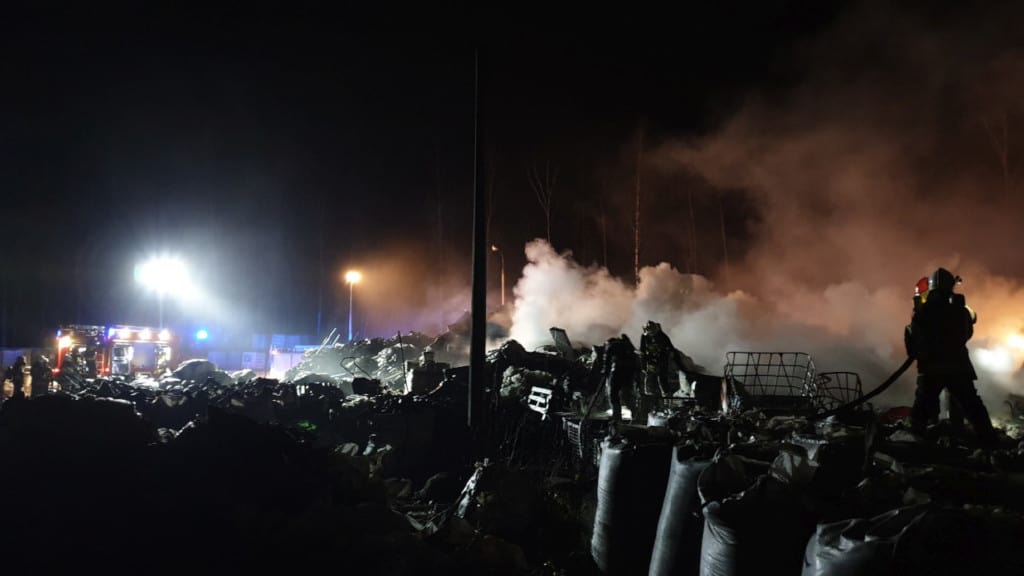
Fire at a legal landfill in November 2019 | photo: katowice.kwpsp.gov.pl
Still, the criminals don’t give up – illegal shipments of waste to Poland are just too profitable, both for companies that produce it, and for those “taking care” of it. In Poland, the transport and storage of waste costs only around 350 zloty (80 euro), while prices of toxic waste utilisation are even ten times higher. This trend is true both in Poland, where only several companies carry out professional hazardous waste disposal, and in Western Europe.
Garbage on fire
According to the Inspection of Environmental Protection, as of May 11th, about 260 illegal dumps of toxic waste were identified all over the country, with an estimated total mass of at least 451 000 tons. Some of those places are over a decade old; others have been set up or identified just recently. And new cases are reported every month, many of them associated with notorious waste fraudsters. Two years after the scale of the problem has drawn attention, new stories are hauntingly familiar.
In April 2020, a fire of a scale equal to Jakubów took place in the village of Nowiny. The burning site used to be a legal landfill operating since 2018, with permit refuted after 1300 tons of mauzers with toxic waste were found onsite. The formal owner was sentenced to over a year in prison in October 2019, his case was connected to the garbage mafia activities.
If not for the fire, the costs of disposal would amount to 30 million zloty.
Little is known about the extent of contamination yet but according to the Inspection of Environmental Protection, “analyses of sewage generated during the rescue and firefighting operation showed high concentrations of phenol index, of cadmium, chromium, zinc, nickel, copper, as well as anthracene and naphthalene.” Ammonia, styrene, acetone and nitric acid vapours were detected in the air.
Detection of one landfill leads to the detection of another, as locations are usually geographically or personally related. Close to Nowiny, two other landfills connected to the same people are waiting to be neutralised. In the village of Szołajdy, dozens of containers with carcinogenic substances were found on a private property in October 2019. Several locations in two voivodeships have been linked to another criminal group, convicted in 2018. Also recently, a discovery of 1,5 millions of litres of flammable and toxic waste in Jasieniec, directed the prosecutor to several more landfills and led to an arrest of over a dozen people. Presumably many locations are yet to be found.
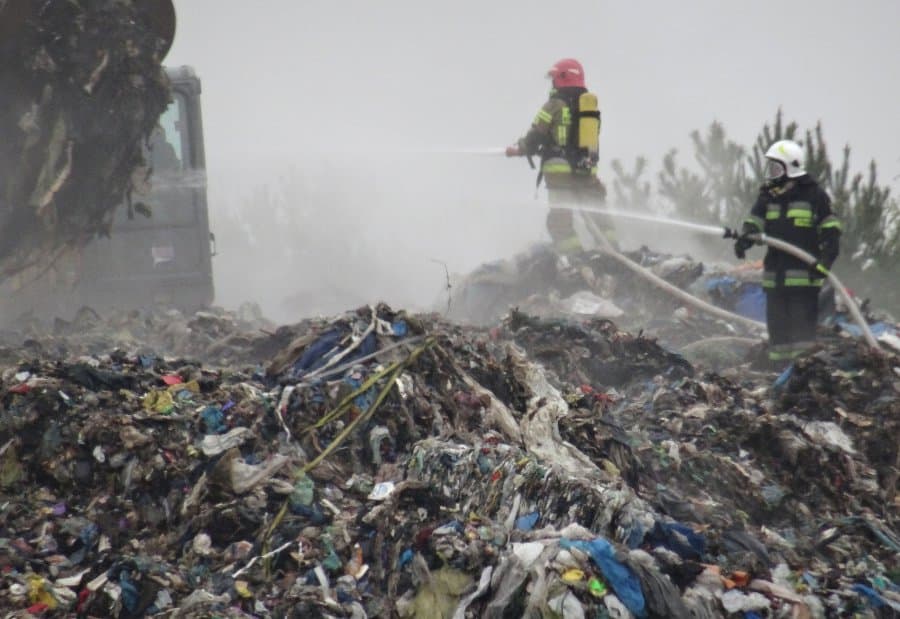
20 firemen units tried to extinguish fire at one of the landfills in Świętokrzyskie region. It was the 8th time this landfill was on fire in less than a year. | photo: kielce.uw.gov.pl/
A kiss of death
In September 2019 in Glogow, a 10 minute drive from Jakubów, five men were caught red-handed by the police, while attempting to transport 168 mauzers of petroleum waste, acids and other corrosive substances onto the site of a former junkyard. The site, which has been identified as an illegal landfill in 2018, also belongs to Janusz G., who is still awaiting his conviction.
“We surprised the criminals by setting up cameras covering the landfill site”, says vice-president of Glogow, Wojciech Borecki. “And thanks to this monitoring they were successfully stopped while trying to deliver another portion of the waste to this area. We provided evidence to the prosecutor’s office. But for us, there’s little satisfaction. The waste is still there, and we don’t have the funds to dispose of it.”
As the waste is stored on private grounds, responsibility should fall on the owner. In reality, it’s the local governments that are forced to take action instead, while the true culprit escapes financial punishment. “That is 3,600 tons of waste”, says Borecki. “At the end of 2018, we estimated the cost of export and disposal at 11.5 million zloty but in the meantime, prices have increased. Previously, utilisation of one ton of such waste cost 3,500 zloty. Today companies dealing with the utilisation of waste take 9 or even 10 thousand zloty per ton. Therefore, the current cost may fluctuate around PLN 30 million. We are trying to obtain the funds necessary to dispose of the waste but without the help of state authorities, we cannot do it.”
A fund of 300 millions of zloty was set up by the Polish government to allow local governments to cover the costs of cleaning up abandoned waste but the solution is not equally available. Borecki explains that the amount of allocated funds depends on the municipality’s income indicator – Glogow, a fairly wealthy city, could recover only 10% of the costs. “Reaching for these funds is like a kiss of death – we would get, for example, 3 million zlotys but we would still have to add 27 million. It’s an amount of money that we do not have. Local governments cannot physically afford to get into debt like that.”
The fund may also grant a loan that should be reimbursed after the costs are reclaimed from the waste owner. The possibility of non-returnable assistance is limited. The priority is given to areas where landfills are located on municipality-owned land. This may explain why the sponsor – National Fund for Environmental Protection and Water Management – has so far received only 13 applications for funds since the launch of the program, for a total amount of 256 million Polish zloty. To date, NFOŚiGW has distributed 159.9 million PLN – over a half of the fund’s resources – among applicants.
For now, Glogow as well as many other cities or rural communes are still looking for funds for waste disposal. But at the same time, they are forced to prepare crisis management plans for the worst-case scenario.
“We were forced to develop a plan to evacuate the whole neighbourhood in case of fire or environmental contamination. The landfill is in the immediate vicinity of the railway line and the Odra River. In the case of fire, these toxic substances alongside extinguishing agents might be washed into Odra. If that happens, voivodeships on the west of the country and Baltic waters would be contaminated on a large scale”, says Wojciech Borecki.
The toxic waste is becoming more and more – word for word – a burning issue during the summer heatwave. And as experts stated in the Szołajdy village, with heat above 28 degrees, it may literally blow up.
A senior OSINT researcher and data analyst at FRONTSTORY.PL, Julia Dauksza has participated in many cross-border investigations. Previously, she collaborated with NGOs in Poland. She has been shortlisted for the Grand Press Award (2021, 2022). She was the recipient of the 2023 Bertha Challenge Fellow.

